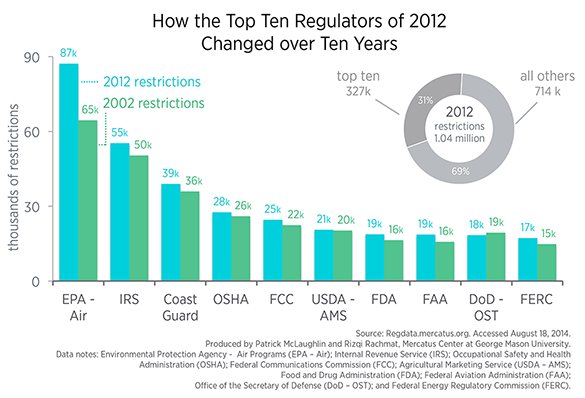- | Regulation Regulation
- | Data Visualizations Data Visualizations
- |
How the Top Ten Regulators of 2012 Changed over Ten Years
RegData 2.0 is a newly launched regulation database that permits users to view regulatory statistics for hundreds of federal agencies. The chart uses statistics pulled from the new RegData website to determine which federal regulators published the most restrictions in the year 2012 and compare the number of restrictions from these regulators in 2012 to the number of restrictions they published ten years earlier.
RegData 2.0 is a newly launched regulation database that permits users to view regulatory statistics for hundreds of federal agencies. The chart below uses statistics pulled from the new RegData website to determine which federal regulators published the most restrictions in the year 2012 and compare the number of restrictions from these regulators in 2012 to the number of restrictions they published ten years earlier.
The bars in the chart show the number of restrictions published by the ten regulators with the most restrictions in 2012 alongside those regulators’ restriction counts in 2002. The doughnut chart shows that these regulators accounted for almost one-third of all restrictions published in 2012. RegData can compare agency-specific regulatory statistics in one year to another year, as done here; it can also plot year-to-year growth for all years between 1997 and 2012. As the figure above shows, growth trends can be quite different from one regulator to another.
Restriction counts are an example of one statistic available with RegData 2.0, which uses text analysis software to search for specific sets of keywords. This particular set of keywords—restrictions—is defined as words likely to create a legally binding obligation to take some action or prohibition from doing so. The specific strings included in this set are “shall,” “must,” “may not,” “prohibited,” and “required.”
Regulators are defined in RegData 2.0 according to the Office of Management and Budget’s MAX system (OMB MAX), with the exception of the Environmental Protection Agency (EPA). The EPA (which is treated as one single regulator by OMB MAX) was divided into different agencies according to the names of the chapters of regulatory text the EPA publishes, such as “Air Programs,” “Water Programs,” and “Pesticide Programs.”
RegData objectively creates a “big picture” window into regulation. It measures not only that overall regulation tends to grow over time, but also which agencies account for that growth. Researchers and analysts can use the data created by RegData to better understand the causes and effects of regulation from specific agencies and on specific industries.


